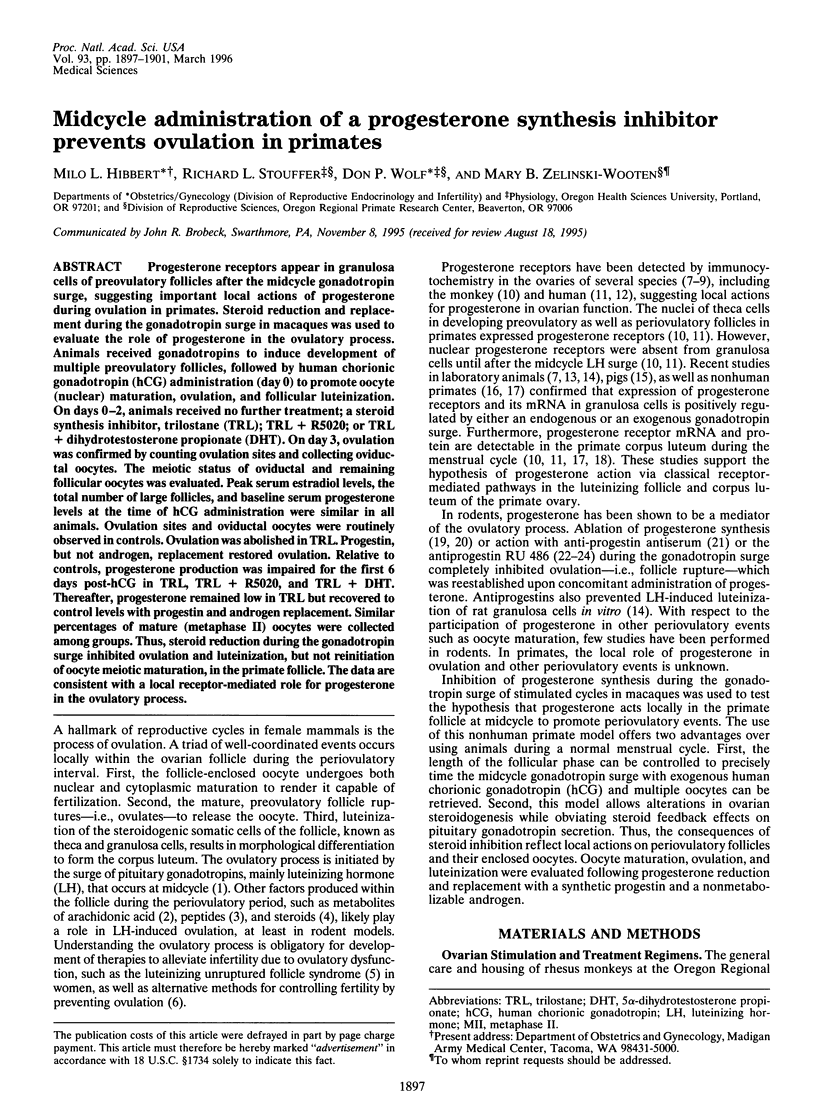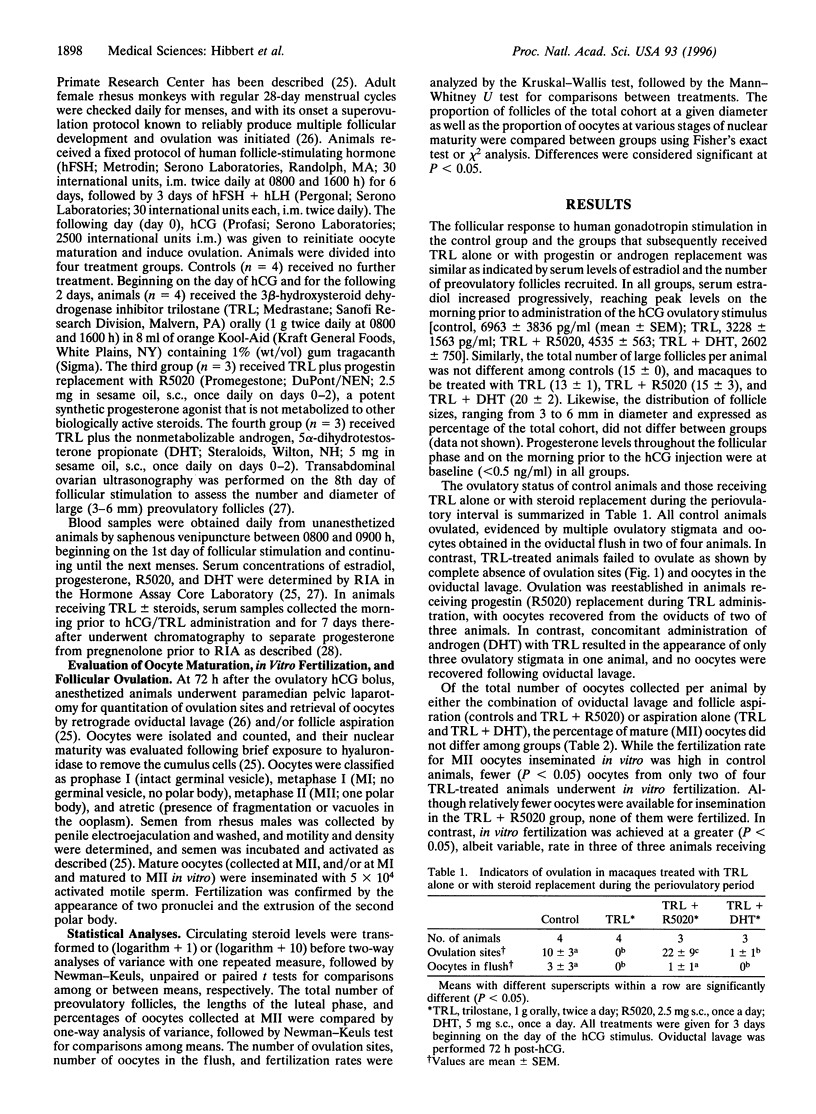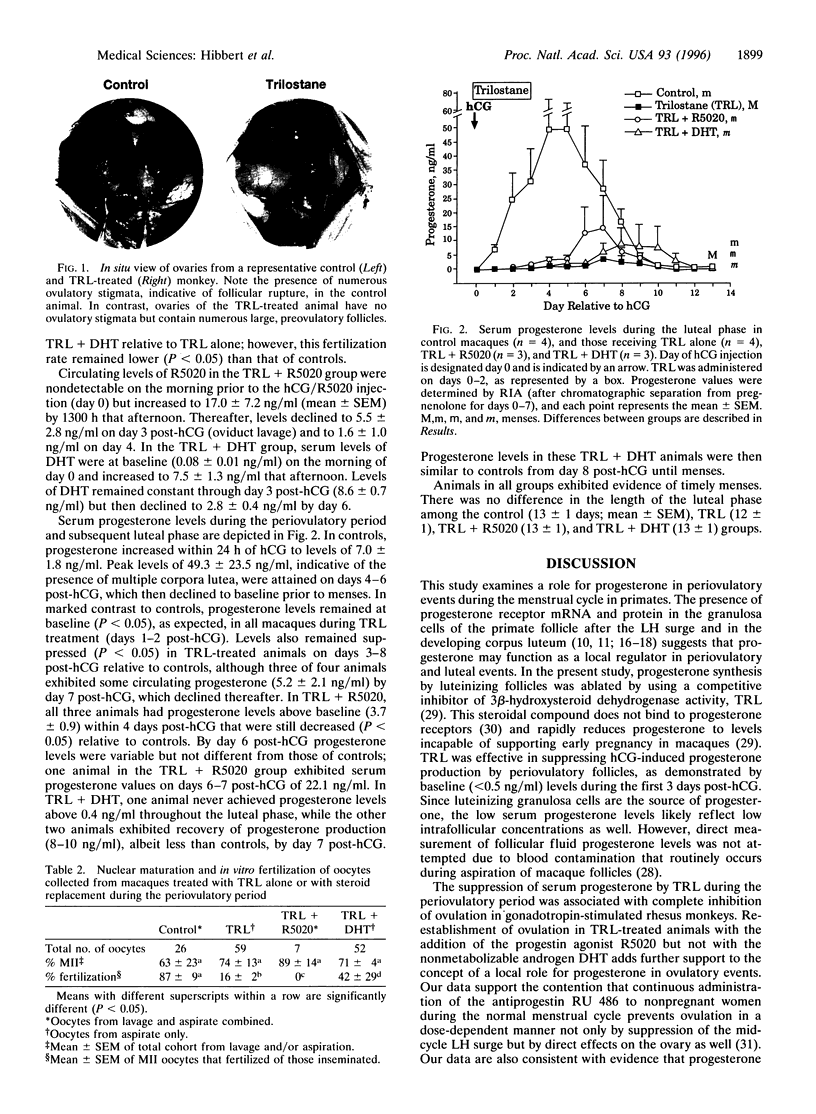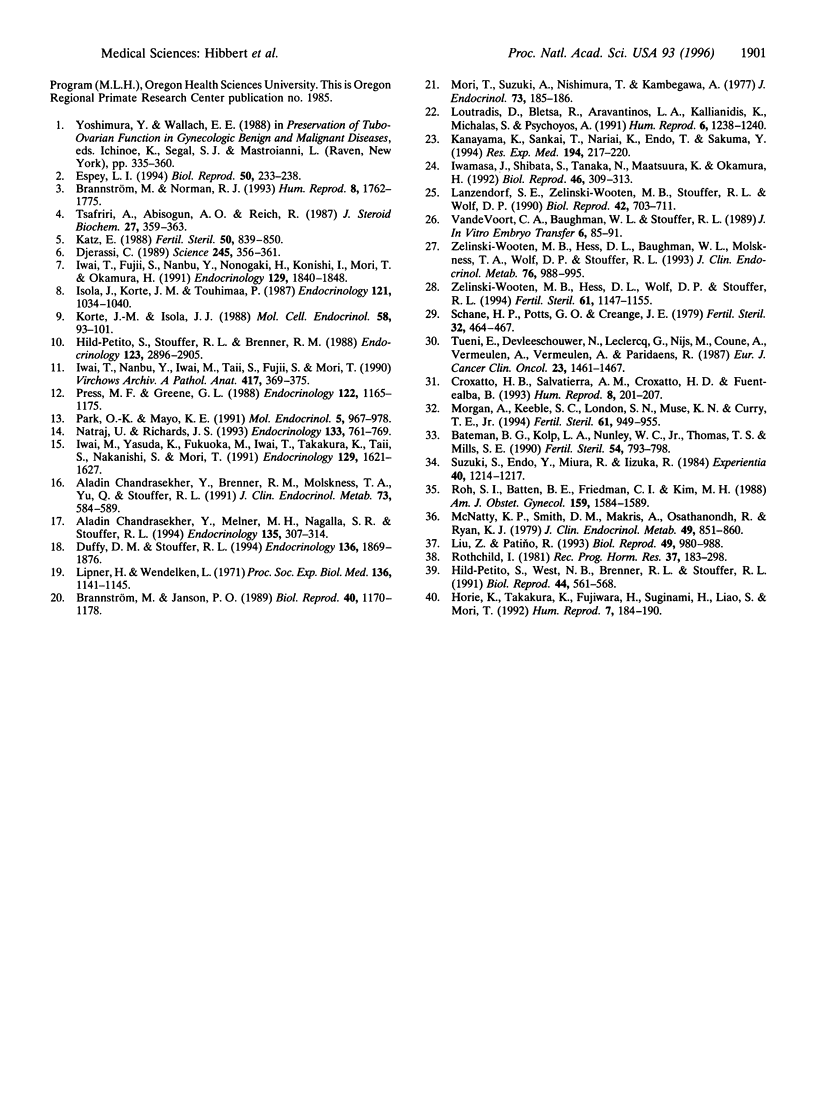Abstract
Progesterone receptors appear in granuloma cells of preovulatory follicles after the midcycle gonadotropin surge, suggesting important local actions of progesterone during ovulation in primates. Steroid reduction and replacement during the gonadotropin surge in macaques was used to evaluate the role of progesterone in the ovulatory process. Animals received gonadotropins to induce development of multiple preovulatory follicles, followed by human chorionic gonadotropin (hCG) administration (day 0) to promote oocyte (nuclear) maturation, ovulation, and follicular luteinization. On days 0-2, animals received no further treatment; a steroid synthesis inhibitor, trilostane (TRL); TRL + R5020; or TRL + dihydrotestosterone propionate (DHT). On day 3, ovulation was confirmed by counting ovulation sites and collecting oviductal oocytes. The meiotic status of oviductal and remaining follicular oocytes was evaluated. Peak serum estradiol levels, the total number of large follicles, and baseline serum progesterone levels at the time of hCG administration were similar in all animals. Ovulation sites and oviductal oocytes were routinely observed in controls. Ovulation was abolished in TRL. Progestin, but not androgen, replacement restored ovulation. Relative to controls, progesterone production was impaired for the first 6 days post-hCG in TRL, TRL + R5020, and TRL + DHT. Thereafter, progesterone remained low in TRL but recovered to control levels with progestin and androgen replacement. Similar percentages of mature (metaphase II) oocytes were collected among groups. Thus, steroid reduction during the gonadotropin surge inhibited ovulation and luteinization, but not reinitiation of oocyte meiotic maturation, in the primate follicle. The data are consistent with a local receptor-mediated role for progesterone in the ovulatory process.
Full text
PDF




Images in this article
Selected References
These references are in PubMed. This may not be the complete list of references from this article.
- Bateman B. G., Kolp L. A., Nunley W. C., Jr, Thomas T. S., Mills S. E. Oocyte retention after follicle luteinization. Fertil Steril. 1990 Nov;54(5):793–798. [PubMed] [Google Scholar]
- Brännström M., Janson P. O. Progesterone is a mediator in the ovulatory process of the in vitro-perfused rat ovary. Biol Reprod. 1989 Jun;40(6):1170–1178. doi: 10.1095/biolreprod40.6.1170. [DOI] [PubMed] [Google Scholar]
- Brännström M., Norman R. J. Involvement of leukocytes and cytokines in the ovulatory process and corpus luteum function. Hum Reprod. 1993 Oct;8(10):1762–1775. doi: 10.1093/oxfordjournals.humrep.a137929. [DOI] [PubMed] [Google Scholar]
- Chandrasekher Y. A., Brenner R. M., Molskness T. A., Yu Q., Stouffer R. L. Titrating luteinizing hormone surge requirements for ovulatory changes in primate follicles. II. Progesterone receptor expression in luteinizing granulosa cells. J Clin Endocrinol Metab. 1991 Sep;73(3):584–589. doi: 10.1210/jcem-73-3-584. [DOI] [PubMed] [Google Scholar]
- Chandrasekher Y. A., Melner M. H., Nagalla S. R., Stouffer R. L. Progesterone receptor, but not estradiol receptor, messenger ribonucleic acid is expressed in luteinizing granulosa cells and the corpus luteum in rhesus monkeys. Endocrinology. 1994 Jul;135(1):307–314. doi: 10.1210/endo.135.1.8013365. [DOI] [PubMed] [Google Scholar]
- Croxatto H. B., Salvatierra A. M., Croxatto H. D., Fuentealba B. Effects of continuous treatment with low dose mifepristone throughout one menstrual cycle. Hum Reprod. 1993 Feb;8(2):201–207. doi: 10.1093/oxfordjournals.humrep.a138022. [DOI] [PubMed] [Google Scholar]
- Djerassi C. The bitter pill. Science. 1989 Jul 28;245(4916):356–361. doi: 10.1126/science.2667135. [DOI] [PubMed] [Google Scholar]
- Duffy D. M., Stouffer R. L. Progesterone receptor messenger ribonucleic acid in the primate corpus luteum during the menstrual cycle: possible regulation by progesterone. Endocrinology. 1995 May;136(5):1869–1876. doi: 10.1210/endo.136.5.7720632. [DOI] [PubMed] [Google Scholar]
- Espey L. L. Current status of the hypothesis that mammalian ovulation is comparable to an inflammatory reaction. Biol Reprod. 1994 Feb;50(2):233–238. doi: 10.1095/biolreprod50.2.233. [DOI] [PubMed] [Google Scholar]
- Hild-Petito S., Stouffer R. L., Brenner R. M. Immunocytochemical localization of estradiol and progesterone receptors in the monkey ovary throughout the menstrual cycle. Endocrinology. 1988 Dec;123(6):2896–2905. doi: 10.1210/endo-123-6-2896. [DOI] [PubMed] [Google Scholar]
- Hild-Petito S., West N. B., Brenner R. M., Stouffer R. L. Localization of androgen receptor in the follicle and corpus luteum of the primate ovary during the menstrual cycle. Biol Reprod. 1991 Mar;44(3):561–568. doi: 10.1095/biolreprod44.3.561. [DOI] [PubMed] [Google Scholar]
- Horie K., Takakura K., Fujiwara H., Suginami H., Liao S., Mori T. Immunohistochemical localization of androgen receptor in the human ovary throughout the menstrual cycle in relation to oestrogen and progesterone receptor expression. Hum Reprod. 1992 Feb;7(2):184–190. doi: 10.1093/oxfordjournals.humrep.a137614. [DOI] [PubMed] [Google Scholar]
- Isola J., Korte J. M., Tuohimaa P. Immunocytochemical localization of progesterone receptor in the chick ovary. Endocrinology. 1987 Sep;121(3):1034–1040. doi: 10.1210/endo-121-3-1034. [DOI] [PubMed] [Google Scholar]
- Iwai M., Yasuda K., Fukuoka M., Iwai T., Takakura K., Taii S., Nakanishi S., Mori T. Luteinizing hormone induces progesterone receptor gene expression in cultured porcine granulosa cells. Endocrinology. 1991 Sep;129(3):1621–1627. doi: 10.1210/endo-129-3-1621. [DOI] [PubMed] [Google Scholar]
- Iwai T., Fujii S., Nanbu Y., Nonogaki H., Konishi I., Mori T., Okamura H. Effect of human chorionic gonadotropin on the expression of progesterone receptors and estrogen receptors in rabbit ovarian granulosa cells and the uterus. Endocrinology. 1991 Oct;129(4):1840–1848. doi: 10.1210/endo-129-4-1840. [DOI] [PubMed] [Google Scholar]
- Iwai T., Nanbu Y., Iwai M., Taii S., Fujii S., Mori T. Immunohistochemical localization of oestrogen receptors and progesterone receptors in the human ovary throughout the menstrual cycle. Virchows Arch A Pathol Anat Histopathol. 1990;417(5):369–375. doi: 10.1007/BF01606025. [DOI] [PubMed] [Google Scholar]
- Iwamasa J., Shibata S., Tanaka N., Matsuura K., Okamura H. The relationship between ovarian progesterone and proteolytic enzyme activity during ovulation in the gonadotropin-treated immature rat. Biol Reprod. 1992 Feb;46(2):309–313. doi: 10.1095/biolreprod46.2.309. [DOI] [PubMed] [Google Scholar]
- Kanayama K., Sankai T., Nariai K., Endo T., Sakuma Y. Effects of anti-progesterone compound RU486 on ovulation in immature mice treated with PMSG/hCG. Res Exp Med (Berl) 1994;194(4):217–220. doi: 10.1007/BF02576382. [DOI] [PubMed] [Google Scholar]
- Katz E. The luteinized unruptured follicle and other ovulatory dysfunctions. Fertil Steril. 1988 Dec;50(6):839–850. doi: 10.1016/s0015-0282(16)60359-x. [DOI] [PubMed] [Google Scholar]
- Korte J. M., Isola J. J. An immunocytochemical study of the progesterone receptor in rabbit ovary. Mol Cell Endocrinol. 1988 Jul;58(1):93–101. doi: 10.1016/0303-7207(88)90057-3. [DOI] [PubMed] [Google Scholar]
- Lanzendorf S. E., Zelinski-Wooten M. B., Stouffer R. L., Wolf D. P. Maturity at collection and the developmental potential of rhesus monkey oocytes. Biol Reprod. 1990 Apr;42(4):703–711. doi: 10.1095/biolreprod42.4.703. [DOI] [PubMed] [Google Scholar]
- Lipner H., Wendelken L. Inhibition of ovulation by inhibition of steroidogenesis in immature rats. Proc Soc Exp Biol Med. 1971 Apr;136(4):1141–1145. doi: 10.3181/00379727-136-35447. [DOI] [PubMed] [Google Scholar]
- Liu Z., Patiño R. High-affinity binding of progesterone to the plasma membrane of Xenopus oocytes: characteristics of binding and hormonal and developmental control. Biol Reprod. 1993 Nov;49(5):980–988. doi: 10.1095/biolreprod49.5.980. [DOI] [PubMed] [Google Scholar]
- Loutradis D., Bletsa R., Aravantinos L., Kallianidis K., Michalas S., Psychoyos A. Preovulatory effects of the progesterone antagonist mifepristone (RU486) in mice. Hum Reprod. 1991 Oct;6(9):1238–1240. doi: 10.1093/oxfordjournals.humrep.a137519. [DOI] [PubMed] [Google Scholar]
- McNatty K. P., Smith D. M., Makris A., Osathanondh R., Ryan K. J. The microenvironment of the human antral follicle: interrelationships among the steroid levels in antral fluid, the population of granulosa cells, and the status of the oocyte in vivo and in vitro. J Clin Endocrinol Metab. 1979 Dec;49(6):851–860. doi: 10.1210/jcem-49-6-851. [DOI] [PubMed] [Google Scholar]
- Morgan A., Keeble S. C., London S. N., Muse K. N., Curry T. E., Jr Antiprogesterone (RU486) effects on metalloproteinase inhibitor activity in human and rat granulosa cells. Fertil Steril. 1994 May;61(5):949–955. doi: 10.1016/s0015-0282(16)56711-9. [DOI] [PubMed] [Google Scholar]
- Mori T., Suzuki A., Nishimura T., Kambegawa A. Inhibition of ovulation in immature rats by anti-progesterone antiserum. J Endocrinol. 1977 Apr;73(1):185–186. doi: 10.1677/joe.0.0730185. [DOI] [PubMed] [Google Scholar]
- Natraj U., Richards J. S. Hormonal regulation, localization, and functional activity of the progesterone receptor in granulosa cells of rat preovulatory follicles. Endocrinology. 1993 Aug;133(2):761–769. doi: 10.1210/endo.133.2.8344215. [DOI] [PubMed] [Google Scholar]
- Park O. K., Mayo K. E. Transient expression of progesterone receptor messenger RNA in ovarian granulosa cells after the preovulatory luteinizing hormone surge. Mol Endocrinol. 1991 Jul;5(7):967–978. doi: 10.1210/mend-5-7-967. [DOI] [PubMed] [Google Scholar]
- Press M. F., Greene G. L. Localization of progesterone receptor with monoclonal antibodies to the human progestin receptor. Endocrinology. 1988 Mar;122(3):1165–1175. doi: 10.1210/endo-122-3-1165. [DOI] [PubMed] [Google Scholar]
- Roh S. I., Batten B. E., Friedman C. I., Kim M. H. The effects of progesterone antagonist RU 486 on mouse oocyte maturation, ovulation, fertilization, and cleavage. Am J Obstet Gynecol. 1988 Dec;159(6):1584–1589. doi: 10.1016/0002-9378(88)90599-6. [DOI] [PubMed] [Google Scholar]
- Rothchild I. The regulation of the mammalian corpus luteum. Recent Prog Horm Res. 1981;37:183–298. doi: 10.1016/b978-0-12-571137-1.50009-8. [DOI] [PubMed] [Google Scholar]
- Schane H. P., Potts G. O., Creange J. E. Inhibition of ovarian, placental, and adrenal steroidogenesis in the rhesus monkey by trilostane. Fertil Steril. 1979 Oct;32(4):464–467. doi: 10.1016/s0015-0282(16)44306-2. [DOI] [PubMed] [Google Scholar]
- Suzuki S., Endo Y., Miura R., Iizuka R. Biological effects of trilostane in vitro on oocyte maturation and fertilization in the hamster. Experientia. 1984 Nov 15;40(11):1214–1217. doi: 10.1007/BF01946649. [DOI] [PubMed] [Google Scholar]
- Tsafriri A., Abisogun A. O., Reich R. Steroids and follicular rupture at ovulation. J Steroid Biochem. 1987;27(1-3):359–363. doi: 10.1016/0022-4731(87)90328-1. [DOI] [PubMed] [Google Scholar]
- Tueni E., Devleeschouwer N., Leclercq G., Nijs M., Coune A., Vermeulen A., Paridaens R. Endocrine effects of Trilostane: in vitro and in vivo studies. Eur J Cancer Clin Oncol. 1987 Oct;23(10):1461–1467. doi: 10.1016/0277-5379(87)90087-3. [DOI] [PubMed] [Google Scholar]
- Vandevoort C. A., Baughman W. L., Stouffer R. L. Comparison of different regimens of human gonadotropins for superovulation of rhesus monkeys: ovulatory response and subsequent luteal function. J In Vitro Fert Embryo Transf. 1989 Apr;6(2):85–91. doi: 10.1007/BF01130732. [DOI] [PubMed] [Google Scholar]
- Zelinski-Wooten M. B., Hess D. L., Baughman W. L., Molskness T. A., Wolf D. P., Stouffer R. L. Administration of an aromatase inhibitor during the late follicular phase of gonadotropin-treated cycles in rhesus monkeys: effects on follicle development, oocyte maturation, and subsequent luteal function. J Clin Endocrinol Metab. 1993 Apr;76(4):988–995. doi: 10.1210/jcem.76.4.8473415. [DOI] [PubMed] [Google Scholar]
- Zelinski-Wooten M. B., Hess D. L., Wolf D. P., Stouffer R. L. Steroid reduction during ovarian stimulation impairs oocyte fertilization, but not folliculogenesis, in rhesus monkeys. Fertil Steril. 1994 Jun;61(6):1147–1155. [PubMed] [Google Scholar]



